MTG - Card Choices in Pioneer
Introduction
Pioneer is the best constructed magic format at the moment. For me, Pioneer combines the best traits from modern and Standard.
Like Standard, the format is not prohibitively expensive to get into. Arguably the best deck in the format, Izzet Phoenix, costs around $300. This is quite a difference to most modern decks, which are much more expensive, this makes it difficult for new players to get into Modern.
It is also a format where combat often matters - I enjoy having a board of creatures, my opponent having a board of creatures and having some interesting attack and block calculations.
The mana base is similar to Standard, as there are no fetch lands in Pioneer (you don’t have to shuffle every turn!). Considering this, it is no surprise that the two top decks in Pioneer are both two-color decks. Five-color decks do exist, but this comes at a real cost in consistency.
Unlike Standard and Modern, Pioneer is a non-rotating format. Standard rotates every two or three years, after rotation old cards are not legal anymore. It is different for Modern: Modern rotates every time a new Modern Horizon set is printed, and while the old cards stay legal they are not relevant anymore.
Modern has an active community and there are many modern events. Here in Switzerland we have a growing Pioneer community and there are weekly events in many parts of the country. Currently, it is difficult to find Standard events for paper play.
Card Choices Matter
We just come from an exciting Pro Tour that introduced a new deck: Rakdos Vampires. Rakdos Vampires has been a strong choice since its first appearance. However, if you go back and take a look at the list played by Seth Manfield that won Pro Tour Murders at Karlov Manor, you notice that, since then, the deck has evolved.
In this article, I go over the most played decks in Pioneer and check how successful different configurations have been in tournaments in the last 20 days.
State of the Format
Currently, Izzet Phoenix and Rakdos Vampire are the two most popular decks. They make up roughly 40% of the field. Amalia Combo, Waste Not, Lotus Field, and Bring to Light account for roughly another 30% of the field.
| Deck | PR% | WR% | 95% CI: [L, U] | #matches |
|---|---|---|---|---|
| Rakdos Vampires | 22.5 | 52.56 | [51.36%, 53.76%] | 1463 |
| Izzet Phoenix | 16.46 | 51.36 | [49.95%, 52.77%] | 1141 |
| Amalia Combo | 9.31 | 49.05 | [47.34%, 50.76%] | 630 |
| Waste Not | 7.78 | 50.36 | [48.47%, 52.25%] | 552 |
| Lotus Field | 6.88 | 43.56 | [41.27%, 45.85%] | 427 |
| Bring to Light | 6.6 | 49.55 | [47.35%, 51.74%] | 440 |
| Spirits | 4.51 | 51.12 | [48.91%, 53.33%] | 356 |
| Transmogrify | 3.82 | 52.65 | [49.48%, 55.83%] | 264 |
| UW Control | 3.68 | 48.05 | [45.13%, 50.97%] | 256 |
| Boros Heroic | 3.33 | 48.61 | [45.37%, 51.85%] | 216 |
| Ensoul Artifact | 2.43 | 48.84 | [45.5 %, 52.18%] | 172 |
| Enigmatic Fires | 1.32 | 55.68 | [52.08%, 59.29%] | 88 |
Reading Example
Rakdos Vampires is the deck with the highest play rate: 22.5% of all decks registered in the last 20 days were of this archetype. The average win rate of this deck was 52.56%.
We are 95% certain that the true win rate of Rakdos Vampires is between 51.36% and 53.76%. The number of matches that are included in this analysis is 1463.
Rakdos Vampire
Every deck that includes at least three main decks, Vein Rippers and Sorin, Imperious Bloodlords, counts as a Rakdos Vampire deck.
Sample lists: https://www.mtggoldfish.com/archetype/pioneer-rakdos-vampires
Archfiend of the Dross
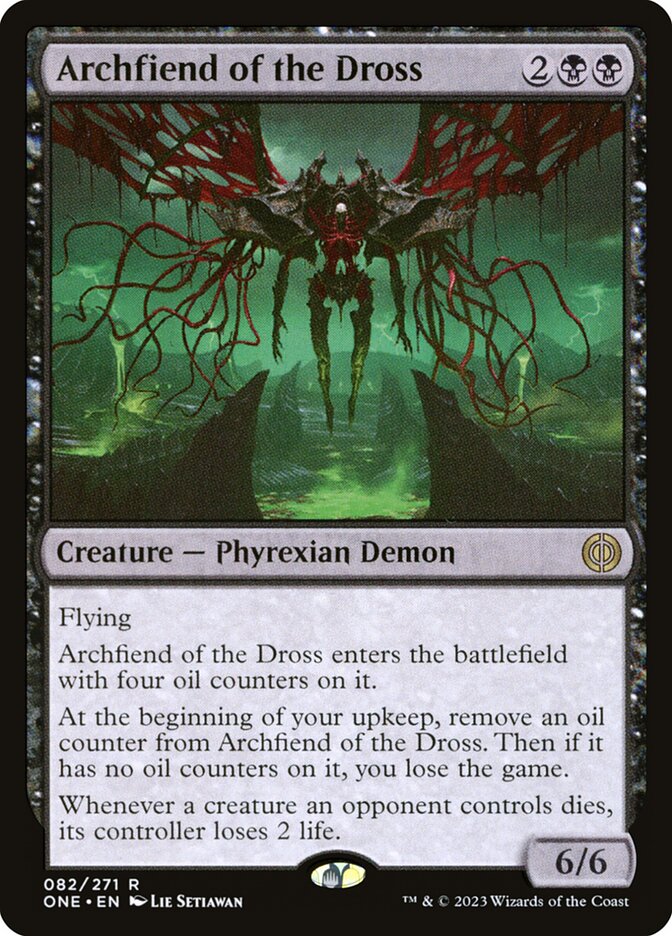
| # | Deck | PR% | WR% | 95% CI: [L, U] | #matches |
|---|---|---|---|---|---|
| 1 | Rakdos Vampires (3x Archfiend of the Dross) | 10.07 | 54.6 | [52.82%, 56.38%] | 663 |
| 2 | Rakdos Vampires (0x Archfiend of the Dross) | 9.51 | 50.67 | [48.76%, 52.57%] | 600 |
| 3 | Rakdos Vampires (2x Archfiend of the Dross) | 2.29 | 53.75 | [50.5 %, 57.0 %] | 160 |
| 4 | Rakdos Vampires (1x Archfiend of the Dross) | 0.35 | 50.0 | [40.07%, 59.93%] | 24 |
| 5 | Rakdos Vampires (4x Archfiend of the Dross) | 0.28 | 31.25 | [19.55%, 42.95%] | 16 |
Interestingly, there is an almost even split between lists that play AotD 3 times in their 75, and lists that do not play it at all. However, the observed win rates are very clear. Apparently the version playing Archfiend of the Dross is stronger than the version not playing AotD.
Archfiend of the Dross is played, because it is very strong against Izzet Phoenix and generally decent in most matchups. For decks with red removal (like Izzet Phoenix), this card is problematic, as all red removal is damage based and usually deals 5 or less damage. This card will stay strong as long as Izzet Phoenix is a big part of the Pioneer metagame and as long as most decks do not play Heartless Act.
Heartless Act
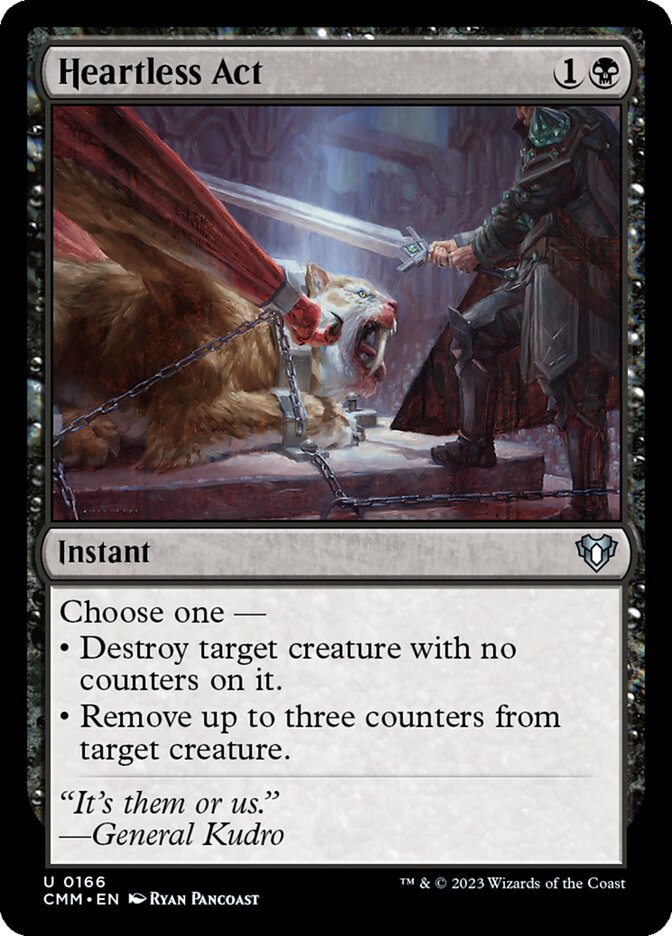
| # | Deck | PR% | WR% | 95% CI: [L, U] | #matches |
|---|---|---|---|---|---|
| 1 | Rakdos Vampires (0x Heartless Act) | 15.49 | 51.84 | [50.37%, 53.31%] | 1032 |
| 2 | Rakdos Vampires (2x Heartless Act) | 5.42 | 53.5 | [51.08%, 55.91%] | 329 |
| 3 | Rakdos Vampires (1x Heartless Act) | 1.25 | 56.96 | [52.27%, 61.66%] | 79 |
| 4 | Rakdos Vampires (3x Heartless Act) | 0.35 | 56.52 | [48.43%, 64.62%] | 23 |
It seems like praying on all those Archfiends pays off. Decks playing Heartless Act had more success than decks not playing it.
Deciding how many Heartless Acts you should play is a fine balancing act - you can’t just jam 4 of them in your main board and call it a day. The card instantly wins the game against Archfiend of the Dross and is good against most creatures. However, it is very bad against creatures with counters. Don’t underestimate the number of creatures with counters on them. Just looking at the top three decks in Pioneer at the moment: Rakdos Vampires has Sorin distributing counters. Izzet Phoenix has Ledger Shredder with counters and Amalia Combo has a few creatures with Explore.
Sheoldred, the Apocalypse
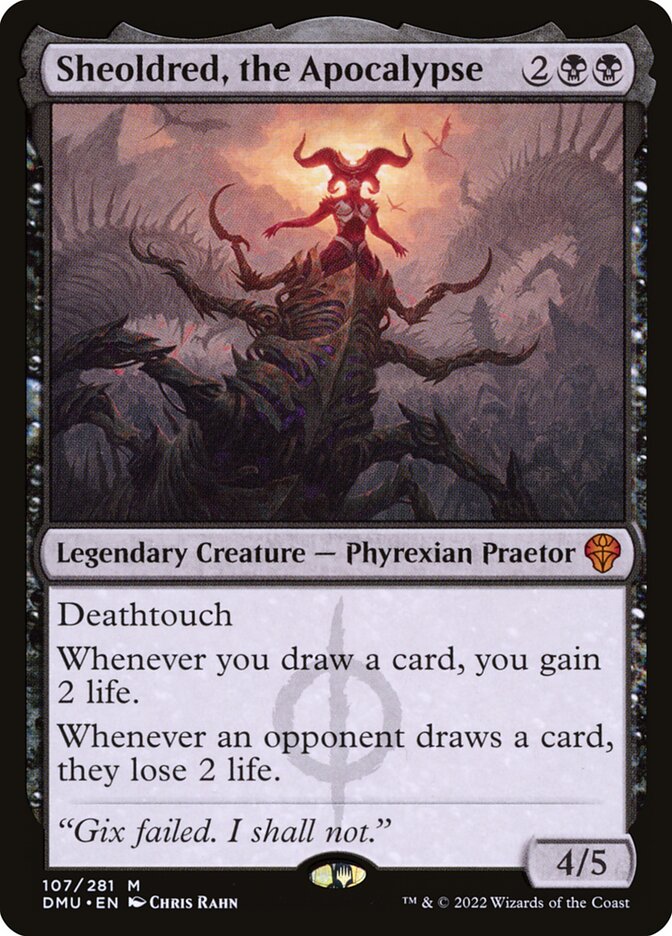
| Deck | PR% | WR% | 95% CI: [L, U] | # Matches |
|---|---|---|---|---|
| Rakdos Vampires (0x Sheoldred, the Apocalypse) | 14.24 | 53.32 | [51.86%, 54.78%] | 934 |
| Rakdos Vampires (2x Sheoldred, the Apocalypse) | 6.25 | 51.8 | [49.31%, 54.30%] | 388 |
| Rakdos Vampires (1x Sheoldred, the Apocalypse) | 1.67 | 47.41 | [42.87%, 51.96%] | 116 |
It seems like the days of Sheoldred are over - at least in Rakdos Vampires. Players opting not to play Sheoldred had the best win rate.
Personally, I think that this is an effect of Archfiend of the Dross being very good right now. They both occupy the same 4-mana creature slot in the deck. Sheoldred is good in matchups where her static abilities are worth more than having a 6/6 creature with Flying. One such matchup is Lotus Field, going off and playing multiple Pore over the Pages is very painful with her around.
Izzet Phoenix
Every deck that contains 4 Arclight Phoenix and runs Fiery Impulse is considered an Izzet Phoenix deck. Sample lists on mtggoldfish
Izzet Phoenix is a midrange/combo/tempo deck. It uses a variety of cantrips to sculpt both hand and graveyard to set up a combo-turn to reanimate a bunch of Arclight Phoenixes. It has a sideboard that enables it to change its strategy to be more controlling by boarding in many counterspells. It can also re-configure itself to be less graveyard dependent by using cards such as Cackling Drake and Young Pyromancer.
Temporal Trespass and Galvanic Iteration
Additional details on these cards can be integrated here depending on their relevance to the current meta or specific interactions within the decks.
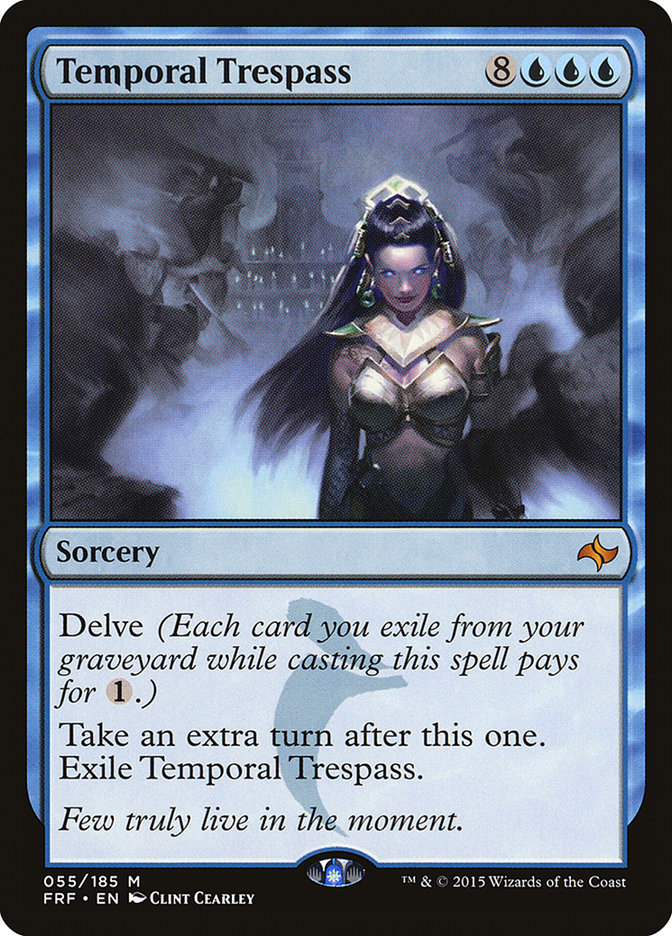
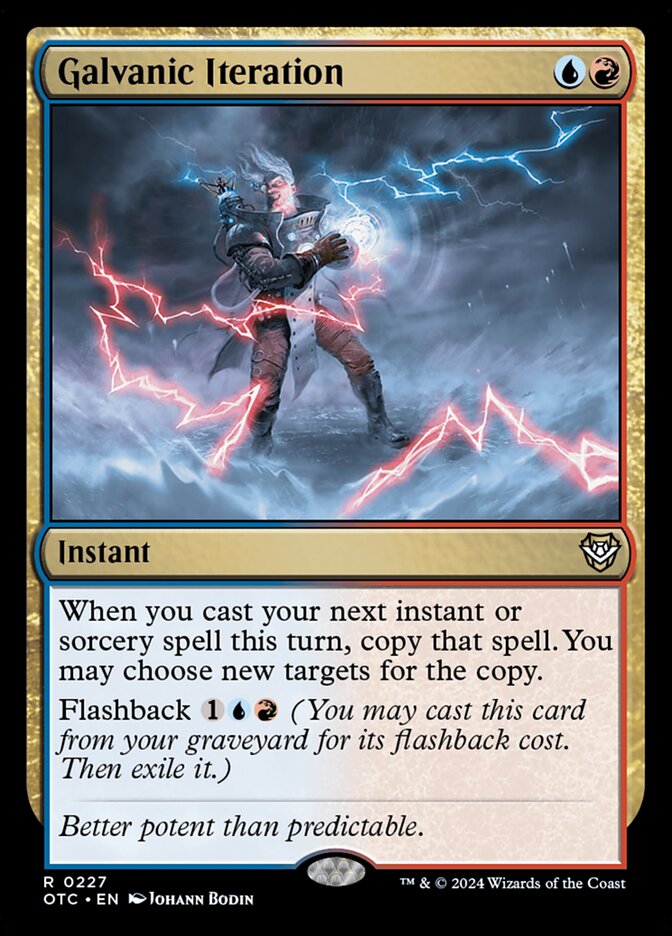
| Deck | PR% | WR% | 95% CI: [L, U] | # Matches |
|---|---|---|---|---|
| Izzet Phoenix (1x TT) (1x GI) | 10.94 | 49.73 | [47.94%, 51.51%] | 728 |
| Izzet Phoenix (1x TT) (2x GI) | 2.41 | 55.90 | [52.18%, 59.62%] | 161 |
| Izzet Phoenix (0x TT) (0x GI) | 1.02 | 57.81 | [52.17%, 63.45%] | 64 |
| Izzet Phoenix (2x TT) (2x GI) | 0.88 | 48.84 | [41.13%, 56.55%] | 43 |
Most Izzet Phoenix lists run Temporal Trespass and Galvanic Iteration. Surprisingly, players were not rewarded for this choice, and lists that do not run Temporal Trespass had the highest win rate. Most players play 1 Temporal Trespass and 1 Galvanic Iteration, so, our sample size of the other configurations is quite small, so take those percentages with a grain of salt.
As a Phoenix player, you will go many games without casting Temporal Trespass, as it is difficult to cast and you need some kind of board presence for it to be even worth it. But maybe it is time to experiment with playing alternatives to Temporal Trespass that are more often useful.
It could also be that playing Temporal Trespass is correct, but the play patterns are simply quite a bit more difficult than just playing other cards in that slot. This would explain why it is so often played: The best players have success with it, and all other players just copy what they see, even though they are less successful with it.
Answers to Rakdos Vampires
Recently, Brazen Borrower gained in popularity to beat Rakdos Vampires. Similarly, new options like Beacon Bolt are explored to have a better chance at fighting Archfiend of the Dross and Vein Ripper.
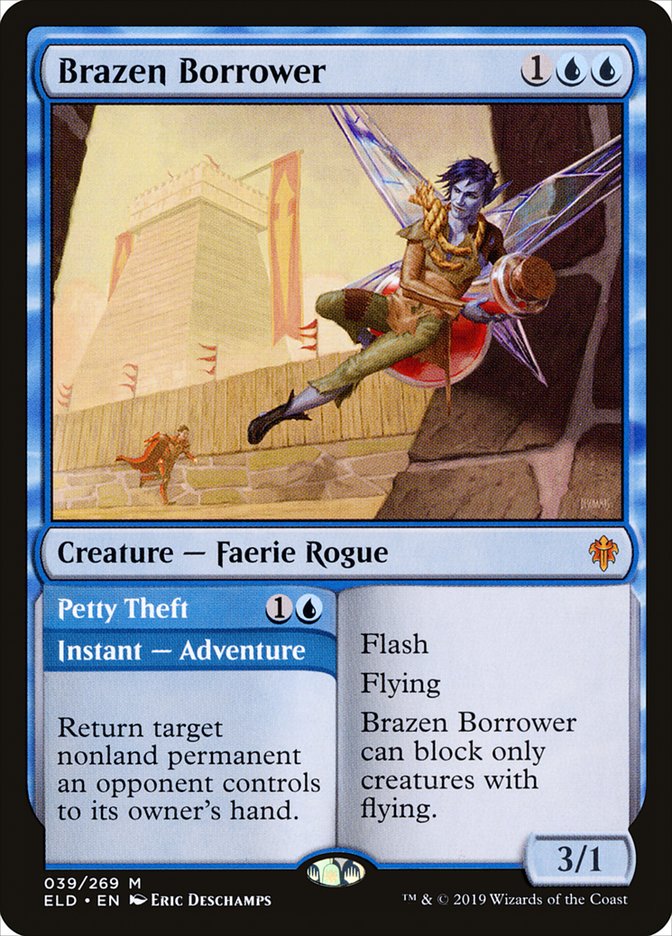
| Deck | PR% | WR% | 95% CI: [L, U] | # Matches |
|---|---|---|---|---|
| Izzet Phoenix (0x Beacon Bolt) | 12.11 | 52.04 | [50.35%, 53.74%] | 807 |
| Izzet Phoenix (1x Beacon Bolt) | 3.43 | 48.5 | [45.05%, 51.95%] | 200 |
It seems like Beacon Bolt is too situational and not really worth a slot in Izzet Phoenix.
In theory, I like this card. If you mill this with a Free the Fae (the instant adventure from Picklock Prankster), you can cast it for its Jump-start cost later if you ever need it. Most of the time, it will deal enough damage to destroy even the largest creature, giving you a clean answer to big Flying creatures like Archfiend of the Dross or Dromoka. However, 3 mana is a lot and it competes with Prismari Command, which can destroy a creature and a hate-piece artifact (like Damping Sphere or Unlicensed Hearse).
| Deck | PR% | WR% | 95% CI: [L, U] | # Matches |
|---|---|---|---|---|
| Izzet Phoenix (1x Brazen Borrower) | 7.95 | 51.68 | [49.42%, 53.95%] | 505 |
| Izzet Phoenix (2x Brazen Borrower) | 7.15 | 51.76 | [49.73%, 53.79%] | 483 |
The data doesn’t tell us much about Brazen Borrower, since almost everyone included one or two copies in their 75.
Note that this is quite a difference from a few months ago (read: before the pro tour that introduced Rakdos Vampires). At that time it was a fringe one-off seen in some side boards.
Now, we see this card more often, as it answers Leyline of the Void and Vein Ripper. Both those cards are often played without paying their mana cost (one via the pre-game action, the other via Sorin), so bouncing those does not necessarily mean that the opponent can easily recast them.
Spell Pierce

| Deck | PR% | WR% | 95% CI: [L, U] | # Matches |
|---|---|---|---|---|
| Izzet Phoenix (2x Spell Pierce) | 9.63 | 50.84 | [49.03%, 52.66%] | 653 |
| Izzet Phoenix (1x Spell Pierce) | 4.52 | 53.05 | [49.99%, 56.12%] | 262 |
| Izzet Phoenix (3x Spell Pierce) | 0.95 | 47.37 | [39.28%, 55.45%] | 57 |
Spell Pierce's strength depends on the current field. The data suggests that most players do not run the optimal number, as only running a single Spell Pierce in the mainboard + the sideboard had a higher win rate than any other number (only two players registered a list without any spell pierces).
Izzet Phoenix had the most success with a configuration that has easy Mainboard access to Phoenixes - every Spell Pierce makes it harder to chain together the necessary three Instants and Sorceries to reanimate them. In the Sideboard, most decks opted to play a combination of Negates and Mystical Disputes. The most successful configuration overall was 1 Spell Pierce Mainboard and 2 Negates, 3 Mystical Disputes in the Sideboard. This allows Izzet Phoenix to radically change its playstyle between pre-sideboard and post-sideboard games.
Data Source
All data comes from the published MTGO decklists available at MTGO Decklists.
Every pioneer tournament that has been played in the last 20 days is included. This is the time frame from 18th of March 2024 until 06th of April, 2024. Results from leagues have not been included.
The data was collected using software I wrote. It is freely available at GitHub.
About the Author
I like playing Magic and talking about Pioneer. Generally, I enjoy analyzing all video- and paper-games I play. In the future, I want to take a look at the other popular decks in the format like Amalia Combo, Waste Not, Bring to Light, and Lotus Field.
If you have comments or a suggestion for an article topic, please reach out to me at dimitri.wessels@gmail.com. I would love to hear from you!
